Marketing Report: Evaluating the Australian Prawns Supply Chain
VerifiedAdded on 2020/04/07
|11
|1590
|132
Report
AI Summary
This report provides a detailed analysis of the Australian prawn supply chain. It begins with an introduction to the product, followed by a mapping of the supply chain, identifying key stakeholders such as suppliers, trade partners, and retailers. The report evaluates the current supply chain, assessing its strengths and weaknesses, and presents a SWOT analysis to highlight opportunities and threats within the industry. Recommendations are provided, focusing on the implementation of Just-in-Time (JIT) inventory management and quality control policies to enhance efficiency and product quality. The report emphasizes the importance of technology, such as mobile applications, to improve supply chain visibility. Furthermore, it suggests the use of quality management tools and techniques, like Economic Order Quantity, to optimize operations and reduce costs. Overall, the report offers valuable insights for stakeholders in the Australian prawn industry, aiming to improve supply chain performance and address key challenges.
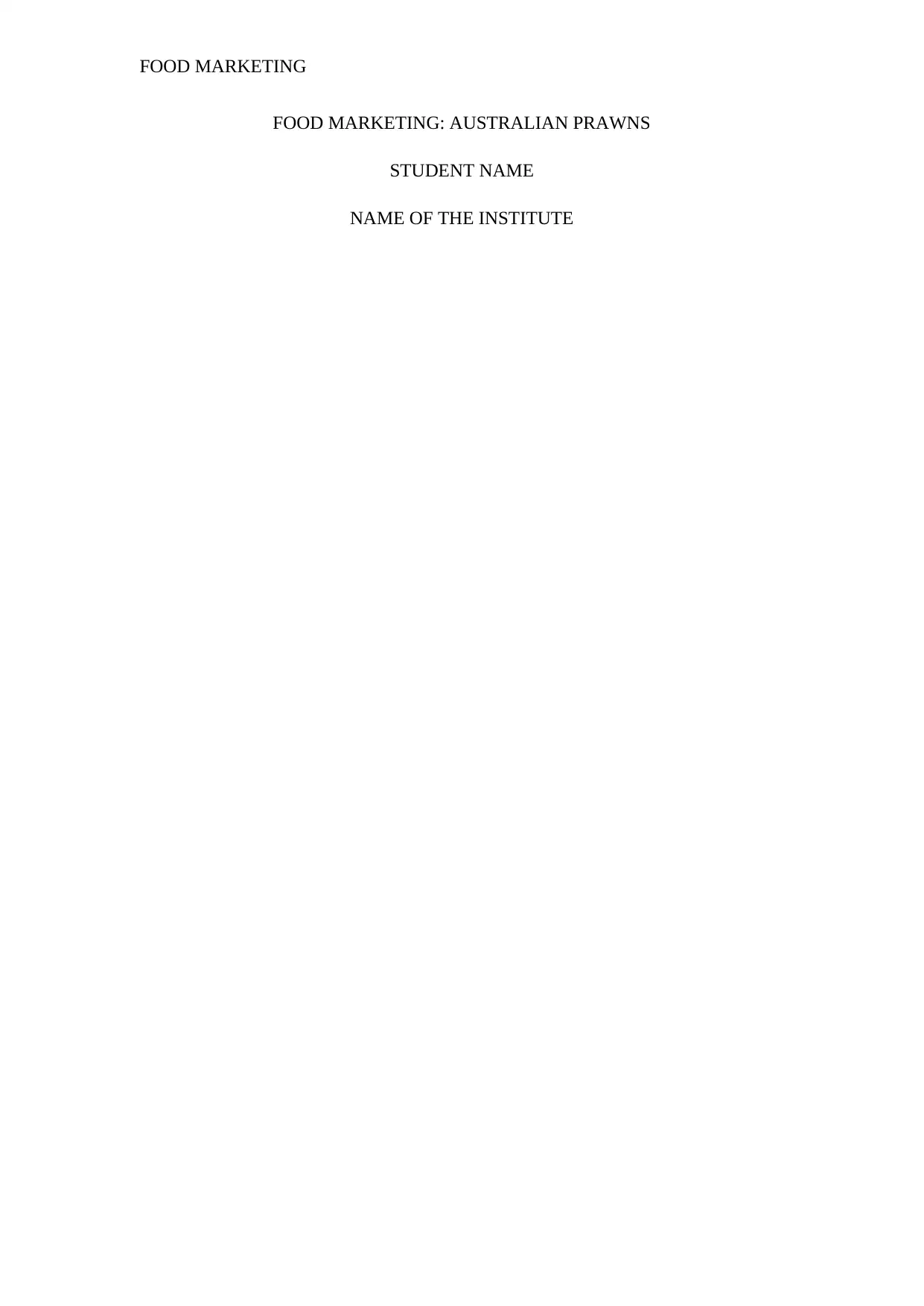
FOOD MARKETING
FOOD MARKETING: AUSTRALIAN PRAWNS
STUDENT NAME
NAME OF THE INSTITUTE
FOOD MARKETING: AUSTRALIAN PRAWNS
STUDENT NAME
NAME OF THE INSTITUTE
Paraphrase This Document
Need a fresh take? Get an instant paraphrase of this document with our AI Paraphraser
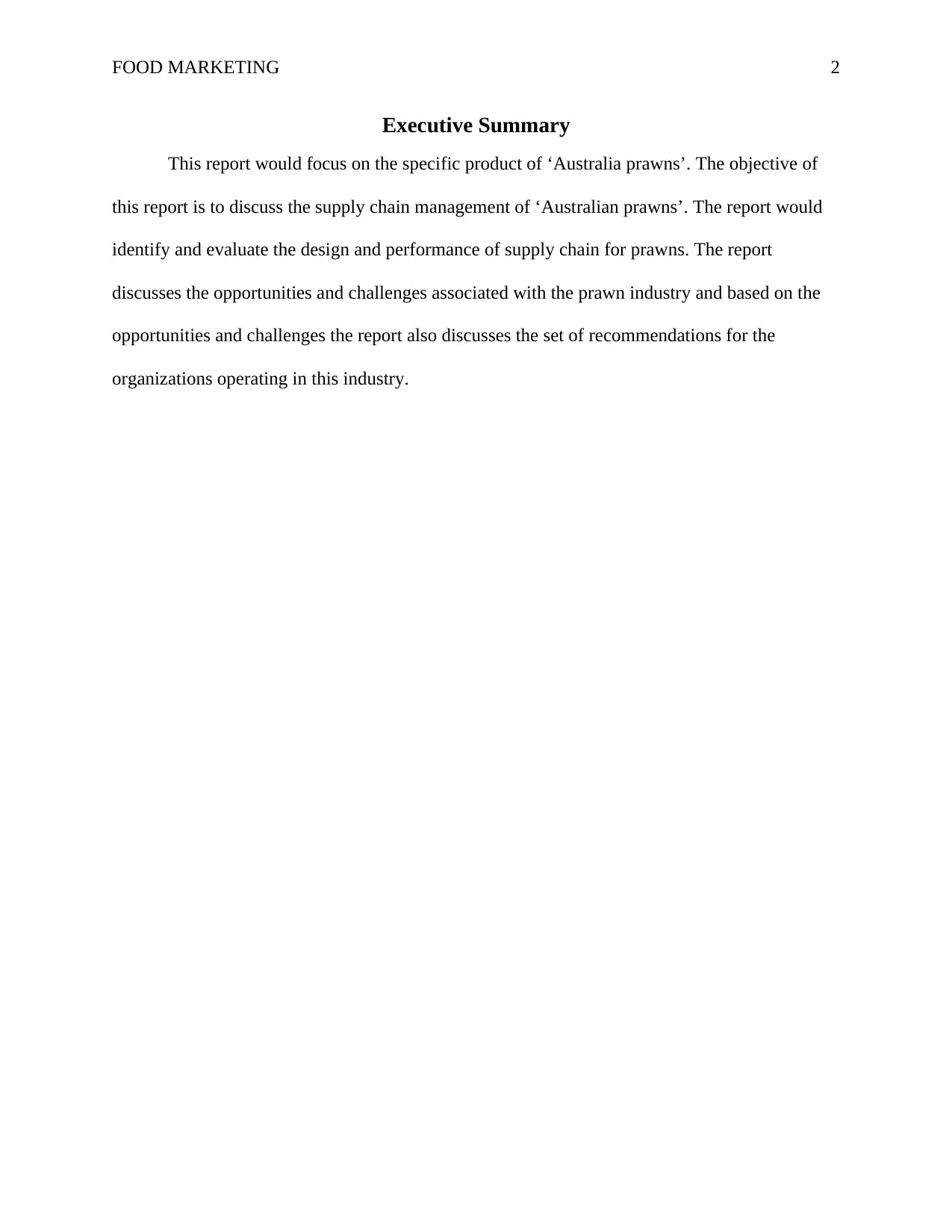
FOOD MARKETING
Executive Summary
This report would focus on the specific product of ‘Australia prawns’. The objective of
this report is to discuss the supply chain management of ‘Australian prawns’. The report would
identify and evaluate the design and performance of supply chain for prawns. The report
discusses the opportunities and challenges associated with the prawn industry and based on the
opportunities and challenges the report also discusses the set of recommendations for the
organizations operating in this industry.
2
Executive Summary
This report would focus on the specific product of ‘Australia prawns’. The objective of
this report is to discuss the supply chain management of ‘Australian prawns’. The report would
identify and evaluate the design and performance of supply chain for prawns. The report
discusses the opportunities and challenges associated with the prawn industry and based on the
opportunities and challenges the report also discusses the set of recommendations for the
organizations operating in this industry.
2
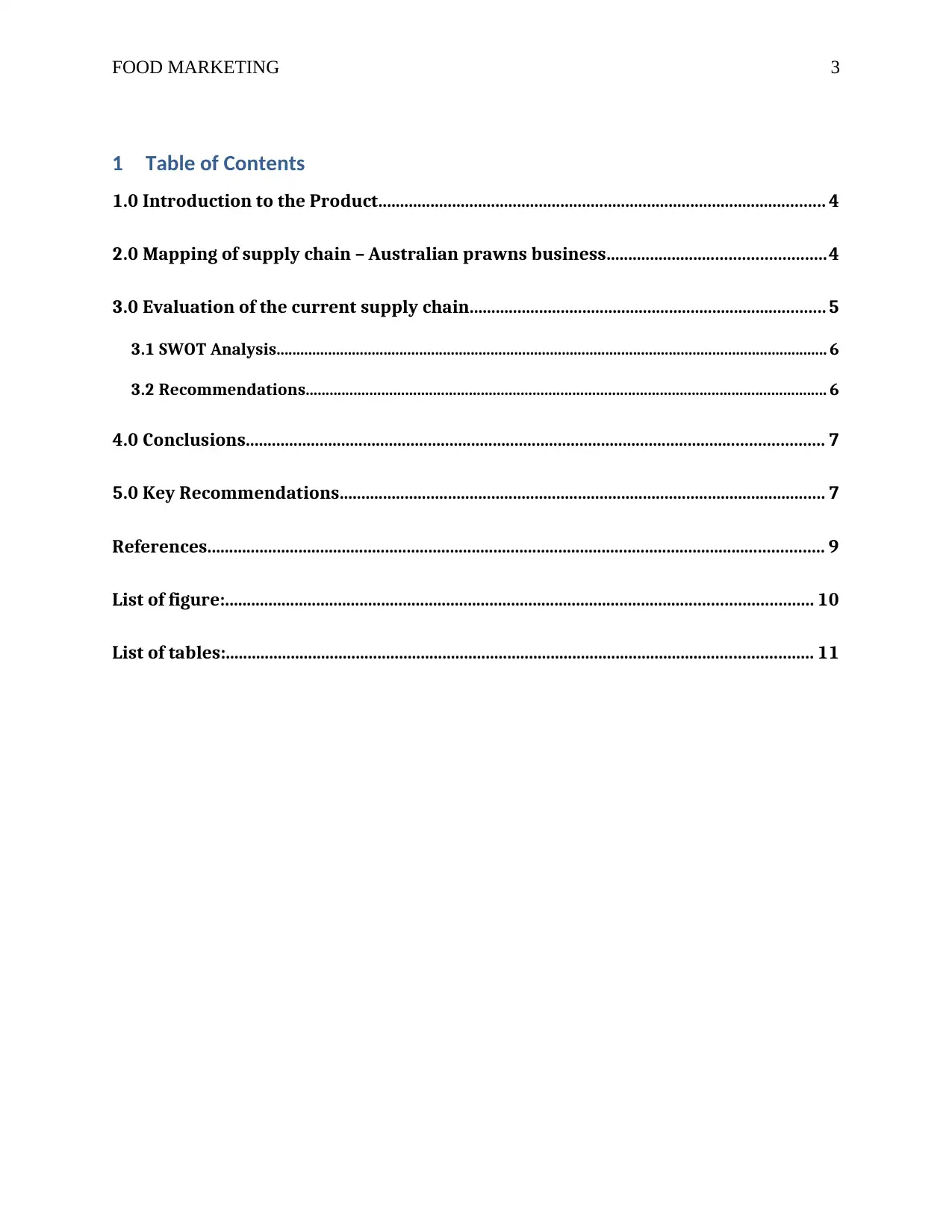
FOOD MARKETING
1 Table of Contents
1.0 Introduction to the Product....................................................................................................... 4
2.0 Mapping of supply chain – Australian prawns business..................................................4
3.0 Evaluation of the current supply chain.................................................................................. 5
3.1 SWOT Analysis........................................................................................................................................... 6
3.2 Recommendations................................................................................................................................... 6
4.0 Conclusions..................................................................................................................................... 7
5.0 Key Recommendations................................................................................................................ 7
References.............................................................................................................................................. 9
List of figure:....................................................................................................................................... 10
List of tables:....................................................................................................................................... 11
3
1 Table of Contents
1.0 Introduction to the Product....................................................................................................... 4
2.0 Mapping of supply chain – Australian prawns business..................................................4
3.0 Evaluation of the current supply chain.................................................................................. 5
3.1 SWOT Analysis........................................................................................................................................... 6
3.2 Recommendations................................................................................................................................... 6
4.0 Conclusions..................................................................................................................................... 7
5.0 Key Recommendations................................................................................................................ 7
References.............................................................................................................................................. 9
List of figure:....................................................................................................................................... 10
List of tables:....................................................................................................................................... 11
3
⊘ This is a preview!⊘
Do you want full access?
Subscribe today to unlock all pages.

Trusted by 1+ million students worldwide
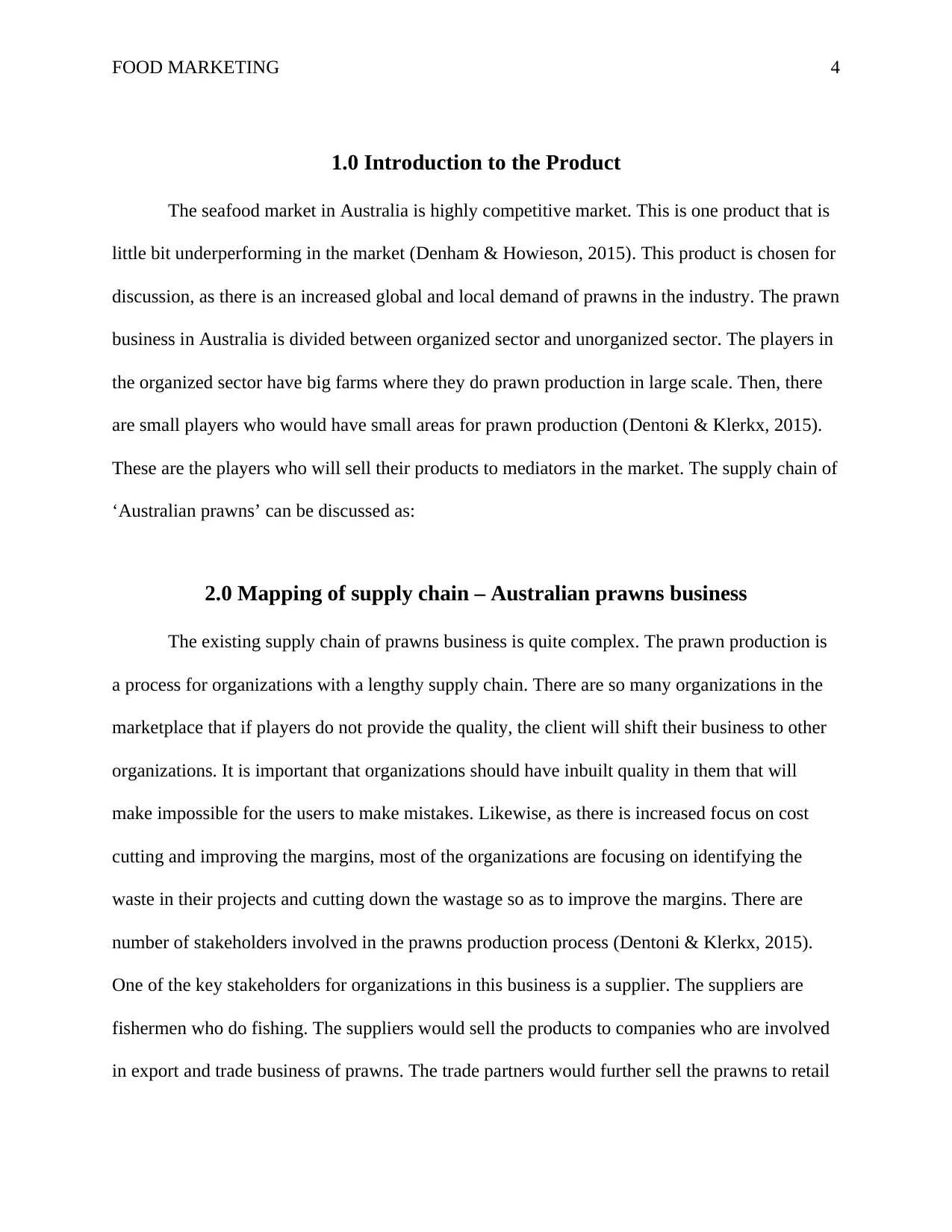
FOOD MARKETING
1.0 Introduction to the Product
The seafood market in Australia is highly competitive market. This is one product that is
little bit underperforming in the market (Denham & Howieson, 2015). This product is chosen for
discussion, as there is an increased global and local demand of prawns in the industry. The prawn
business in Australia is divided between organized sector and unorganized sector. The players in
the organized sector have big farms where they do prawn production in large scale. Then, there
are small players who would have small areas for prawn production (Dentoni & Klerkx, 2015).
These are the players who will sell their products to mediators in the market. The supply chain of
‘Australian prawns’ can be discussed as:
2.0 Mapping of supply chain – Australian prawns business
The existing supply chain of prawns business is quite complex. The prawn production is
a process for organizations with a lengthy supply chain. There are so many organizations in the
marketplace that if players do not provide the quality, the client will shift their business to other
organizations. It is important that organizations should have inbuilt quality in them that will
make impossible for the users to make mistakes. Likewise, as there is increased focus on cost
cutting and improving the margins, most of the organizations are focusing on identifying the
waste in their projects and cutting down the wastage so as to improve the margins. There are
number of stakeholders involved in the prawns production process (Dentoni & Klerkx, 2015).
One of the key stakeholders for organizations in this business is a supplier. The suppliers are
fishermen who do fishing. The suppliers would sell the products to companies who are involved
in export and trade business of prawns. The trade partners would further sell the prawns to retail
4
1.0 Introduction to the Product
The seafood market in Australia is highly competitive market. This is one product that is
little bit underperforming in the market (Denham & Howieson, 2015). This product is chosen for
discussion, as there is an increased global and local demand of prawns in the industry. The prawn
business in Australia is divided between organized sector and unorganized sector. The players in
the organized sector have big farms where they do prawn production in large scale. Then, there
are small players who would have small areas for prawn production (Dentoni & Klerkx, 2015).
These are the players who will sell their products to mediators in the market. The supply chain of
‘Australian prawns’ can be discussed as:
2.0 Mapping of supply chain – Australian prawns business
The existing supply chain of prawns business is quite complex. The prawn production is
a process for organizations with a lengthy supply chain. There are so many organizations in the
marketplace that if players do not provide the quality, the client will shift their business to other
organizations. It is important that organizations should have inbuilt quality in them that will
make impossible for the users to make mistakes. Likewise, as there is increased focus on cost
cutting and improving the margins, most of the organizations are focusing on identifying the
waste in their projects and cutting down the wastage so as to improve the margins. There are
number of stakeholders involved in the prawns production process (Dentoni & Klerkx, 2015).
One of the key stakeholders for organizations in this business is a supplier. The suppliers are
fishermen who do fishing. The suppliers would sell the products to companies who are involved
in export and trade business of prawns. The trade partners would further sell the prawns to retail
4
Paraphrase This Document
Need a fresh take? Get an instant paraphrase of this document with our AI Paraphraser
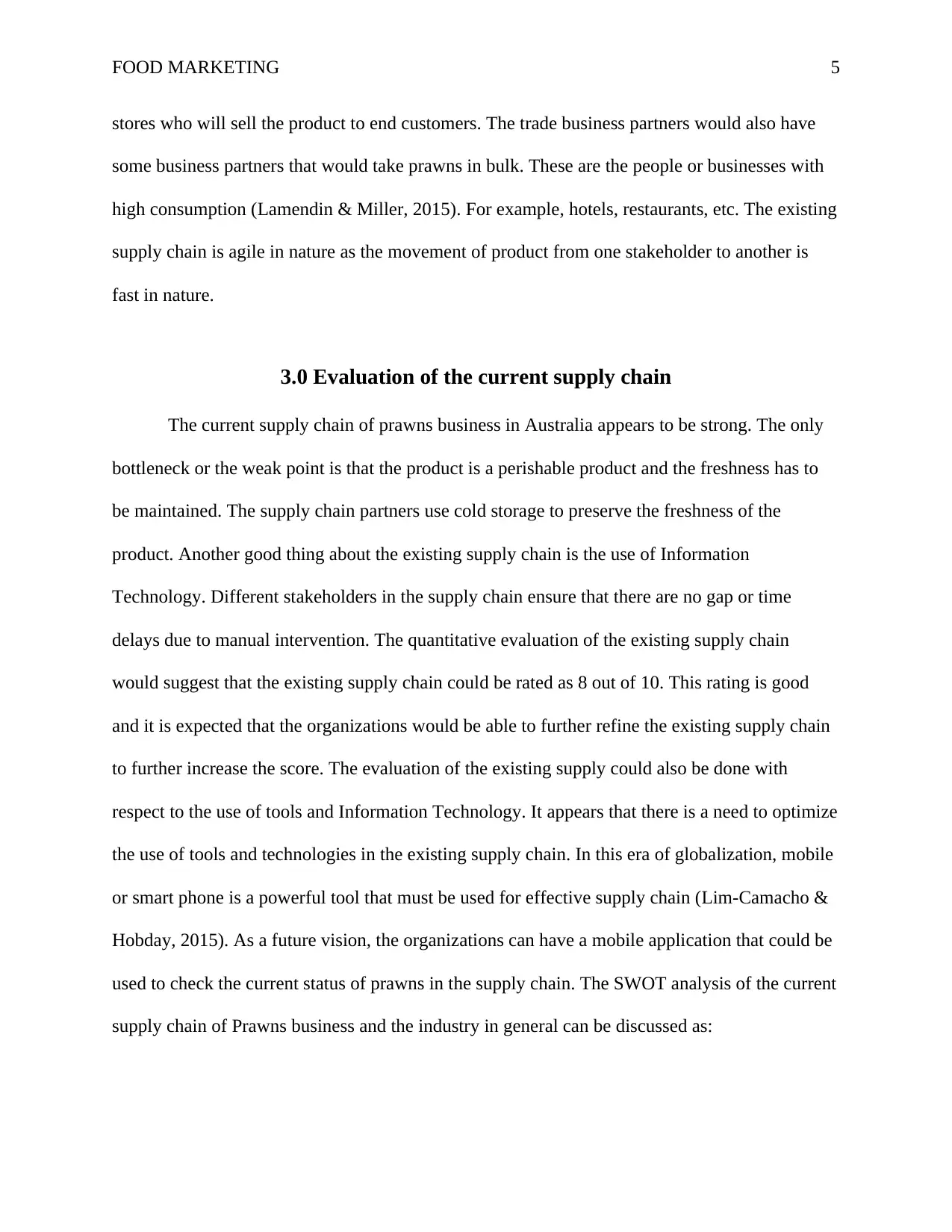
FOOD MARKETING
stores who will sell the product to end customers. The trade business partners would also have
some business partners that would take prawns in bulk. These are the people or businesses with
high consumption (Lamendin & Miller, 2015). For example, hotels, restaurants, etc. The existing
supply chain is agile in nature as the movement of product from one stakeholder to another is
fast in nature.
3.0 Evaluation of the current supply chain
The current supply chain of prawns business in Australia appears to be strong. The only
bottleneck or the weak point is that the product is a perishable product and the freshness has to
be maintained. The supply chain partners use cold storage to preserve the freshness of the
product. Another good thing about the existing supply chain is the use of Information
Technology. Different stakeholders in the supply chain ensure that there are no gap or time
delays due to manual intervention. The quantitative evaluation of the existing supply chain
would suggest that the existing supply chain could be rated as 8 out of 10. This rating is good
and it is expected that the organizations would be able to further refine the existing supply chain
to further increase the score. The evaluation of the existing supply could also be done with
respect to the use of tools and Information Technology. It appears that there is a need to optimize
the use of tools and technologies in the existing supply chain. In this era of globalization, mobile
or smart phone is a powerful tool that must be used for effective supply chain (Lim-Camacho &
Hobday, 2015). As a future vision, the organizations can have a mobile application that could be
used to check the current status of prawns in the supply chain. The SWOT analysis of the current
supply chain of Prawns business and the industry in general can be discussed as:
5
stores who will sell the product to end customers. The trade business partners would also have
some business partners that would take prawns in bulk. These are the people or businesses with
high consumption (Lamendin & Miller, 2015). For example, hotels, restaurants, etc. The existing
supply chain is agile in nature as the movement of product from one stakeholder to another is
fast in nature.
3.0 Evaluation of the current supply chain
The current supply chain of prawns business in Australia appears to be strong. The only
bottleneck or the weak point is that the product is a perishable product and the freshness has to
be maintained. The supply chain partners use cold storage to preserve the freshness of the
product. Another good thing about the existing supply chain is the use of Information
Technology. Different stakeholders in the supply chain ensure that there are no gap or time
delays due to manual intervention. The quantitative evaluation of the existing supply chain
would suggest that the existing supply chain could be rated as 8 out of 10. This rating is good
and it is expected that the organizations would be able to further refine the existing supply chain
to further increase the score. The evaluation of the existing supply could also be done with
respect to the use of tools and Information Technology. It appears that there is a need to optimize
the use of tools and technologies in the existing supply chain. In this era of globalization, mobile
or smart phone is a powerful tool that must be used for effective supply chain (Lim-Camacho &
Hobday, 2015). As a future vision, the organizations can have a mobile application that could be
used to check the current status of prawns in the supply chain. The SWOT analysis of the current
supply chain of Prawns business and the industry in general can be discussed as:
5
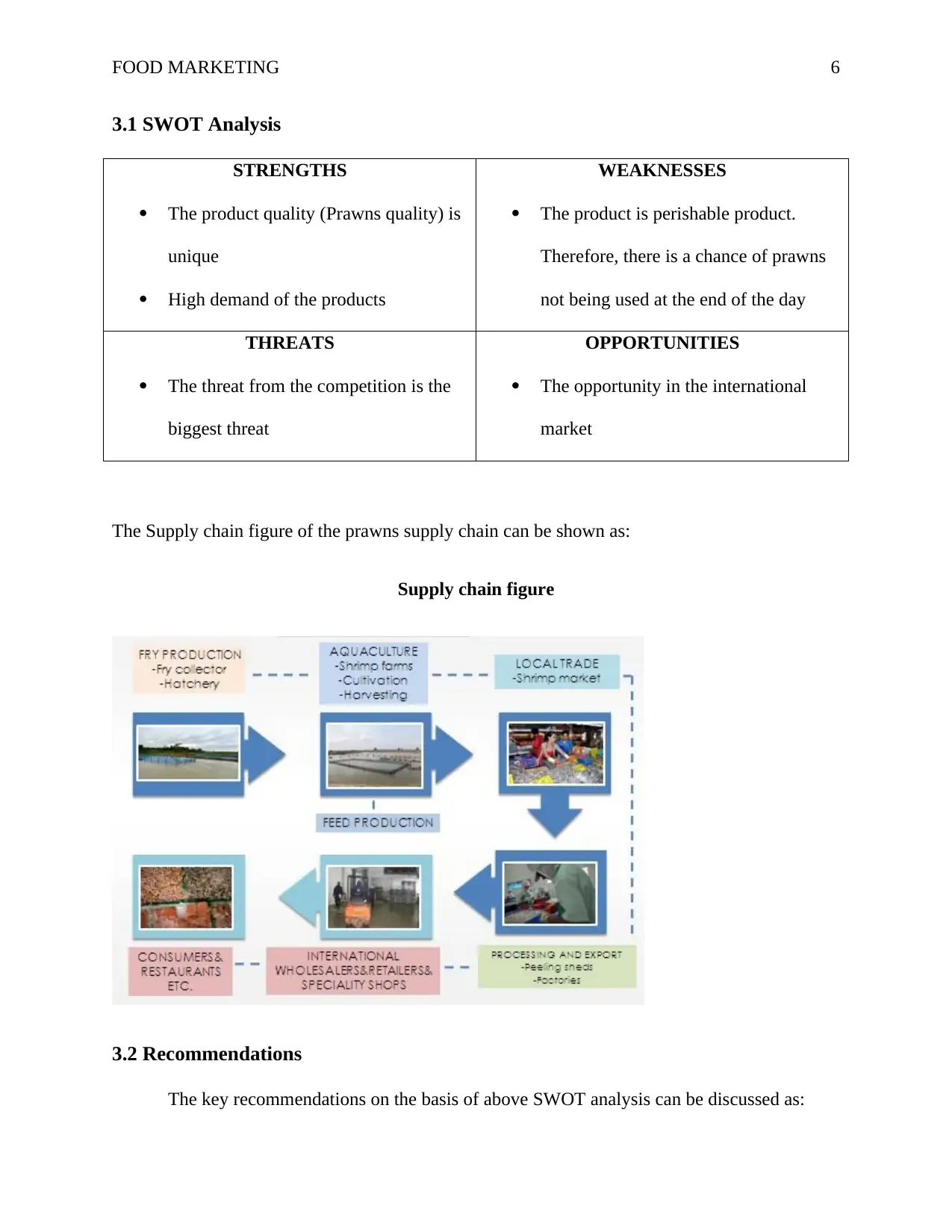
FOOD MARKETING
3.1 SWOT Analysis
STRENGTHS
The product quality (Prawns quality) is
unique
High demand of the products
WEAKNESSES
The product is perishable product.
Therefore, there is a chance of prawns
not being used at the end of the day
THREATS
The threat from the competition is the
biggest threat
OPPORTUNITIES
The opportunity in the international
market
The Supply chain figure of the prawns supply chain can be shown as:
Supply chain figure
3.2 Recommendations
The key recommendations on the basis of above SWOT analysis can be discussed as:
6
3.1 SWOT Analysis
STRENGTHS
The product quality (Prawns quality) is
unique
High demand of the products
WEAKNESSES
The product is perishable product.
Therefore, there is a chance of prawns
not being used at the end of the day
THREATS
The threat from the competition is the
biggest threat
OPPORTUNITIES
The opportunity in the international
market
The Supply chain figure of the prawns supply chain can be shown as:
Supply chain figure
3.2 Recommendations
The key recommendations on the basis of above SWOT analysis can be discussed as:
6
⊘ This is a preview!⊘
Do you want full access?
Subscribe today to unlock all pages.

Trusted by 1+ million students worldwide
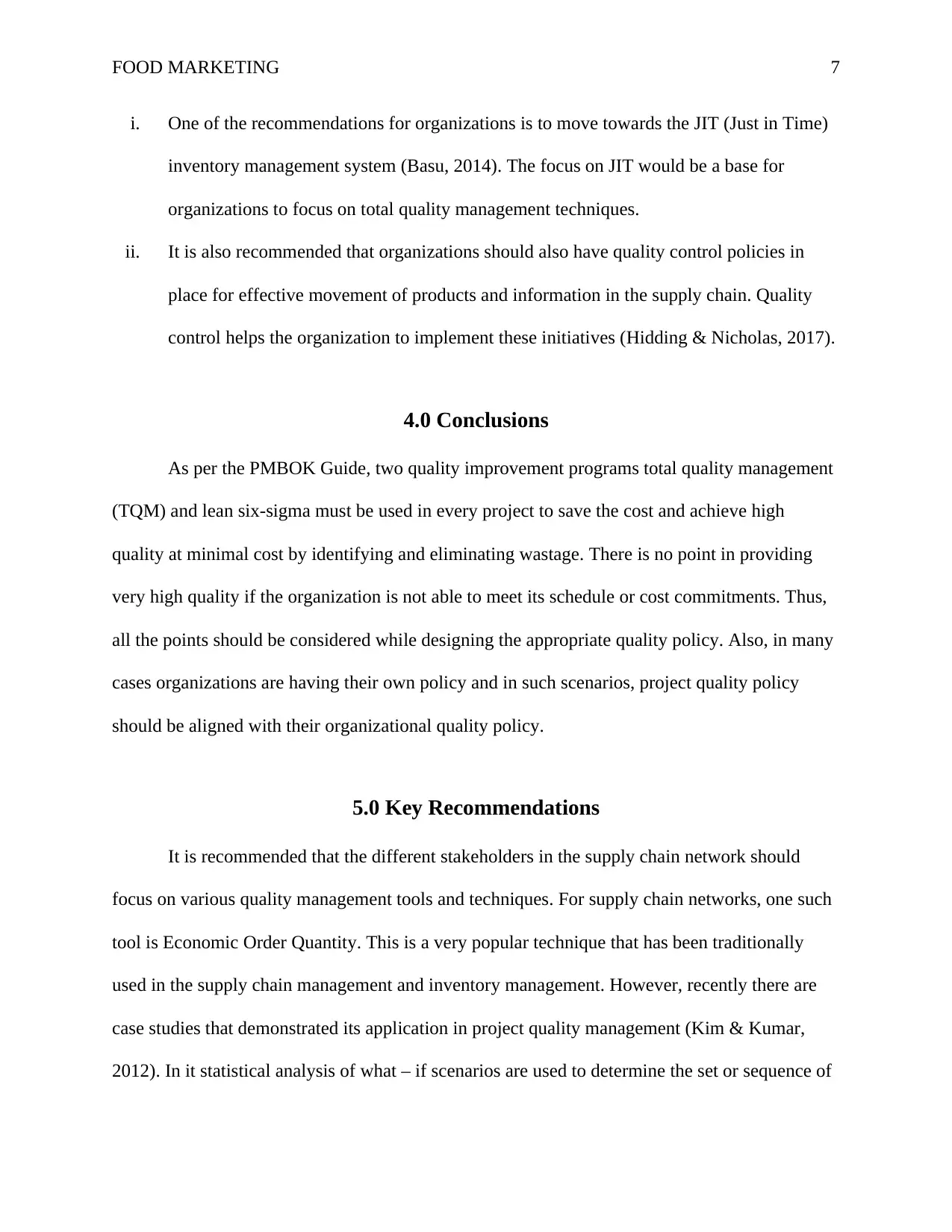
FOOD MARKETING
i. One of the recommendations for organizations is to move towards the JIT (Just in Time)
inventory management system (Basu, 2014). The focus on JIT would be a base for
organizations to focus on total quality management techniques.
ii. It is also recommended that organizations should also have quality control policies in
place for effective movement of products and information in the supply chain. Quality
control helps the organization to implement these initiatives (Hidding & Nicholas, 2017).
4.0 Conclusions
As per the PMBOK Guide, two quality improvement programs total quality management
(TQM) and lean six-sigma must be used in every project to save the cost and achieve high
quality at minimal cost by identifying and eliminating wastage. There is no point in providing
very high quality if the organization is not able to meet its schedule or cost commitments. Thus,
all the points should be considered while designing the appropriate quality policy. Also, in many
cases organizations are having their own policy and in such scenarios, project quality policy
should be aligned with their organizational quality policy.
5.0 Key Recommendations
It is recommended that the different stakeholders in the supply chain network should
focus on various quality management tools and techniques. For supply chain networks, one such
tool is Economic Order Quantity. This is a very popular technique that has been traditionally
used in the supply chain management and inventory management. However, recently there are
case studies that demonstrated its application in project quality management (Kim & Kumar,
2012). In it statistical analysis of what – if scenarios are used to determine the set or sequence of
7
i. One of the recommendations for organizations is to move towards the JIT (Just in Time)
inventory management system (Basu, 2014). The focus on JIT would be a base for
organizations to focus on total quality management techniques.
ii. It is also recommended that organizations should also have quality control policies in
place for effective movement of products and information in the supply chain. Quality
control helps the organization to implement these initiatives (Hidding & Nicholas, 2017).
4.0 Conclusions
As per the PMBOK Guide, two quality improvement programs total quality management
(TQM) and lean six-sigma must be used in every project to save the cost and achieve high
quality at minimal cost by identifying and eliminating wastage. There is no point in providing
very high quality if the organization is not able to meet its schedule or cost commitments. Thus,
all the points should be considered while designing the appropriate quality policy. Also, in many
cases organizations are having their own policy and in such scenarios, project quality policy
should be aligned with their organizational quality policy.
5.0 Key Recommendations
It is recommended that the different stakeholders in the supply chain network should
focus on various quality management tools and techniques. For supply chain networks, one such
tool is Economic Order Quantity. This is a very popular technique that has been traditionally
used in the supply chain management and inventory management. However, recently there are
case studies that demonstrated its application in project quality management (Kim & Kumar,
2012). In it statistical analysis of what – if scenarios are used to determine the set or sequence of
7
Paraphrase This Document
Need a fresh take? Get an instant paraphrase of this document with our AI Paraphraser
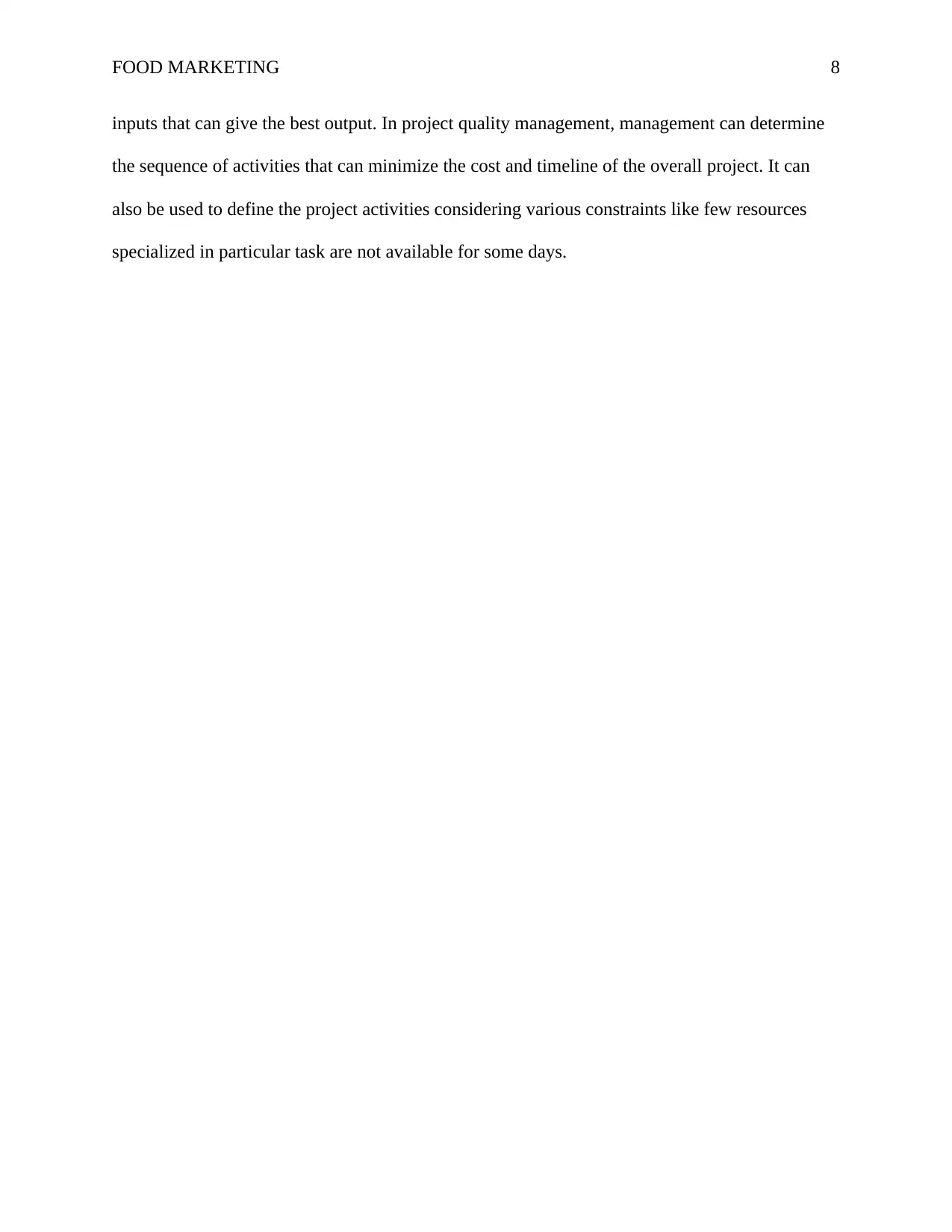
FOOD MARKETING
inputs that can give the best output. In project quality management, management can determine
the sequence of activities that can minimize the cost and timeline of the overall project. It can
also be used to define the project activities considering various constraints like few resources
specialized in particular task are not available for some days.
8
inputs that can give the best output. In project quality management, management can determine
the sequence of activities that can minimize the cost and timeline of the overall project. It can
also be used to define the project activities considering various constraints like few resources
specialized in particular task are not available for some days.
8
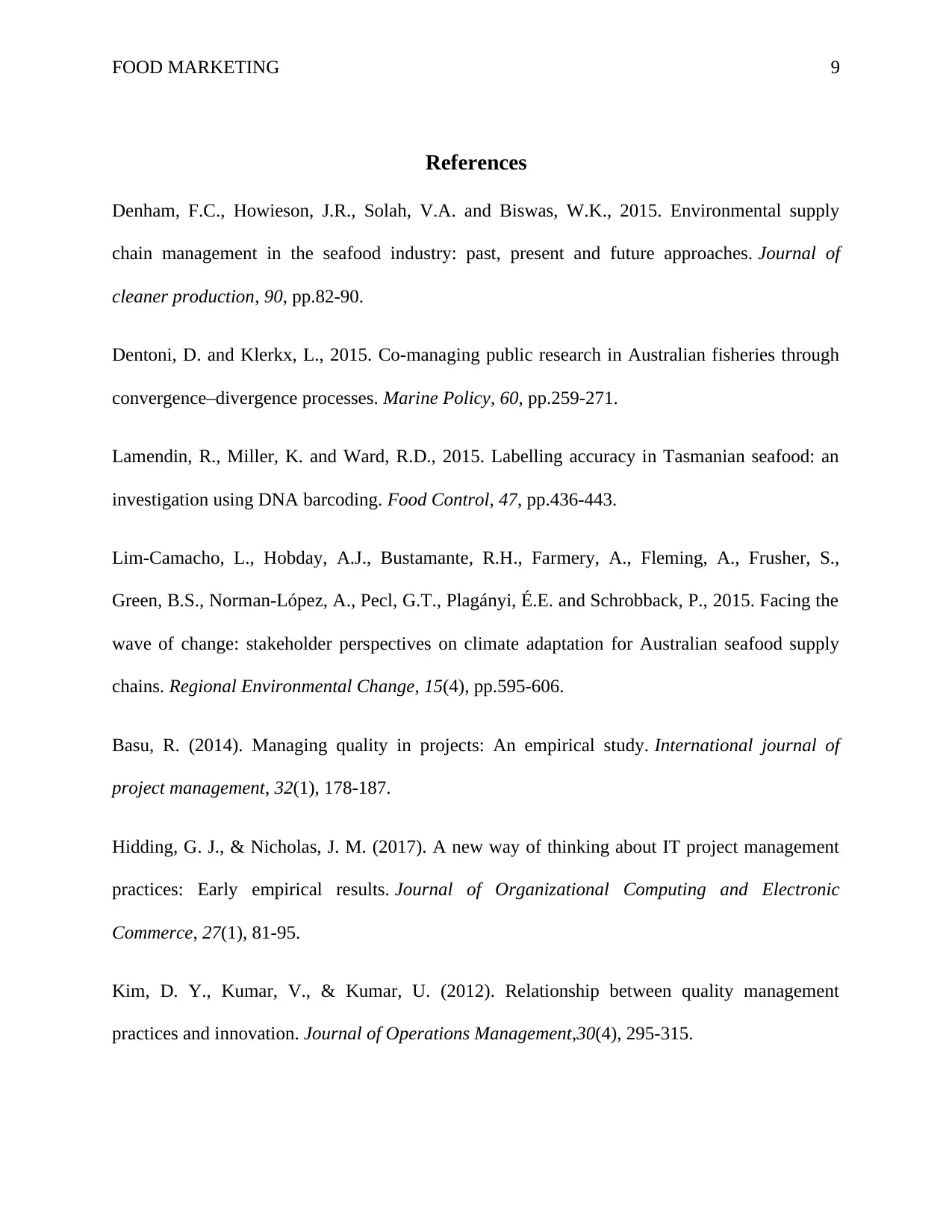
FOOD MARKETING
References
Denham, F.C., Howieson, J.R., Solah, V.A. and Biswas, W.K., 2015. Environmental supply
chain management in the seafood industry: past, present and future approaches. Journal of
cleaner production, 90, pp.82-90.
Dentoni, D. and Klerkx, L., 2015. Co-managing public research in Australian fisheries through
convergence–divergence processes. Marine Policy, 60, pp.259-271.
Lamendin, R., Miller, K. and Ward, R.D., 2015. Labelling accuracy in Tasmanian seafood: an
investigation using DNA barcoding. Food Control, 47, pp.436-443.
Lim-Camacho, L., Hobday, A.J., Bustamante, R.H., Farmery, A., Fleming, A., Frusher, S.,
Green, B.S., Norman-López, A., Pecl, G.T., Plagányi, É.E. and Schrobback, P., 2015. Facing the
wave of change: stakeholder perspectives on climate adaptation for Australian seafood supply
chains. Regional Environmental Change, 15(4), pp.595-606.
Basu, R. (2014). Managing quality in projects: An empirical study. International journal of
project management, 32(1), 178-187.
Hidding, G. J., & Nicholas, J. M. (2017). A new way of thinking about IT project management
practices: Early empirical results. Journal of Organizational Computing and Electronic
Commerce, 27(1), 81-95.
Kim, D. Y., Kumar, V., & Kumar, U. (2012). Relationship between quality management
practices and innovation. Journal of Operations Management,30(4), 295-315.
9
References
Denham, F.C., Howieson, J.R., Solah, V.A. and Biswas, W.K., 2015. Environmental supply
chain management in the seafood industry: past, present and future approaches. Journal of
cleaner production, 90, pp.82-90.
Dentoni, D. and Klerkx, L., 2015. Co-managing public research in Australian fisheries through
convergence–divergence processes. Marine Policy, 60, pp.259-271.
Lamendin, R., Miller, K. and Ward, R.D., 2015. Labelling accuracy in Tasmanian seafood: an
investigation using DNA barcoding. Food Control, 47, pp.436-443.
Lim-Camacho, L., Hobday, A.J., Bustamante, R.H., Farmery, A., Fleming, A., Frusher, S.,
Green, B.S., Norman-López, A., Pecl, G.T., Plagányi, É.E. and Schrobback, P., 2015. Facing the
wave of change: stakeholder perspectives on climate adaptation for Australian seafood supply
chains. Regional Environmental Change, 15(4), pp.595-606.
Basu, R. (2014). Managing quality in projects: An empirical study. International journal of
project management, 32(1), 178-187.
Hidding, G. J., & Nicholas, J. M. (2017). A new way of thinking about IT project management
practices: Early empirical results. Journal of Organizational Computing and Electronic
Commerce, 27(1), 81-95.
Kim, D. Y., Kumar, V., & Kumar, U. (2012). Relationship between quality management
practices and innovation. Journal of Operations Management,30(4), 295-315.
9
⊘ This is a preview!⊘
Do you want full access?
Subscribe today to unlock all pages.

Trusted by 1+ million students worldwide

FOOD MARKETING
List of figure:
Figure 1: Supply chain figure: Page 6
10
List of figure:
Figure 1: Supply chain figure: Page 6
10
Paraphrase This Document
Need a fresh take? Get an instant paraphrase of this document with our AI Paraphraser

FOOD MARKETING
List of tables:
Table 1: SWOT table: Page 6
11
List of tables:
Table 1: SWOT table: Page 6
11
1 out of 11
Related Documents
Your All-in-One AI-Powered Toolkit for Academic Success.
+13062052269
info@desklib.com
Available 24*7 on WhatsApp / Email
![[object Object]](/_next/static/media/star-bottom.7253800d.svg)
Unlock your academic potential
Copyright © 2020–2025 A2Z Services. All Rights Reserved. Developed and managed by ZUCOL.





